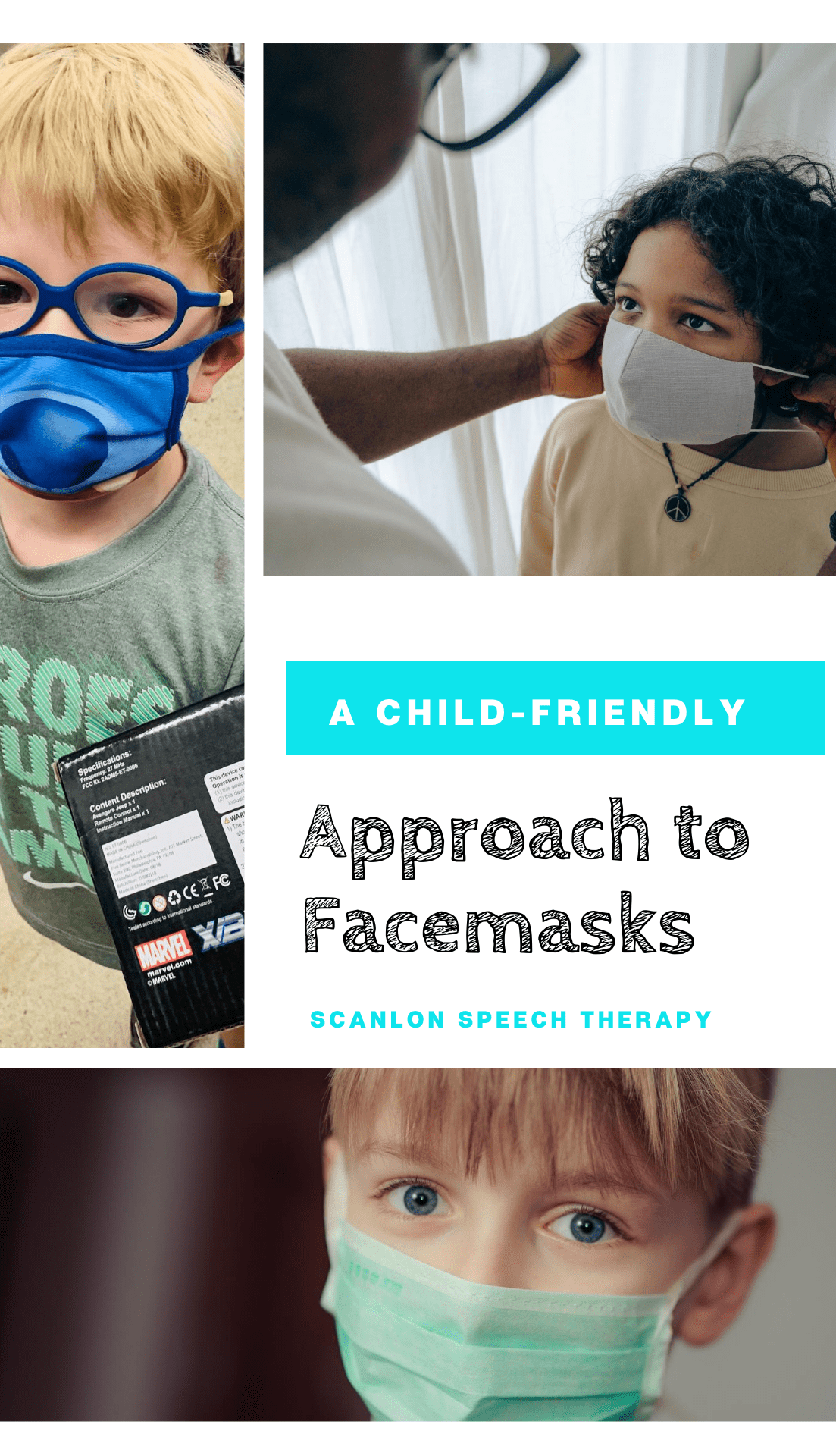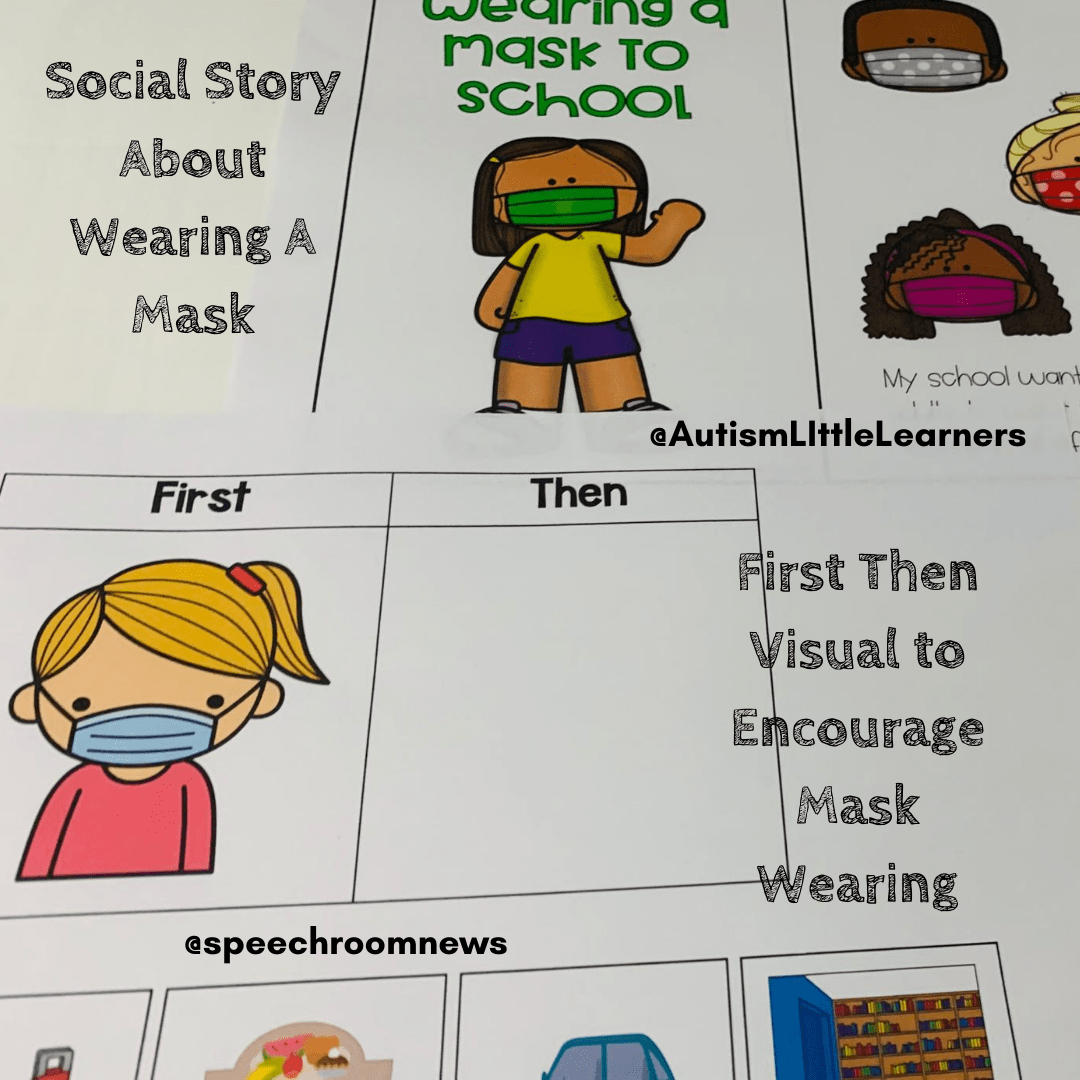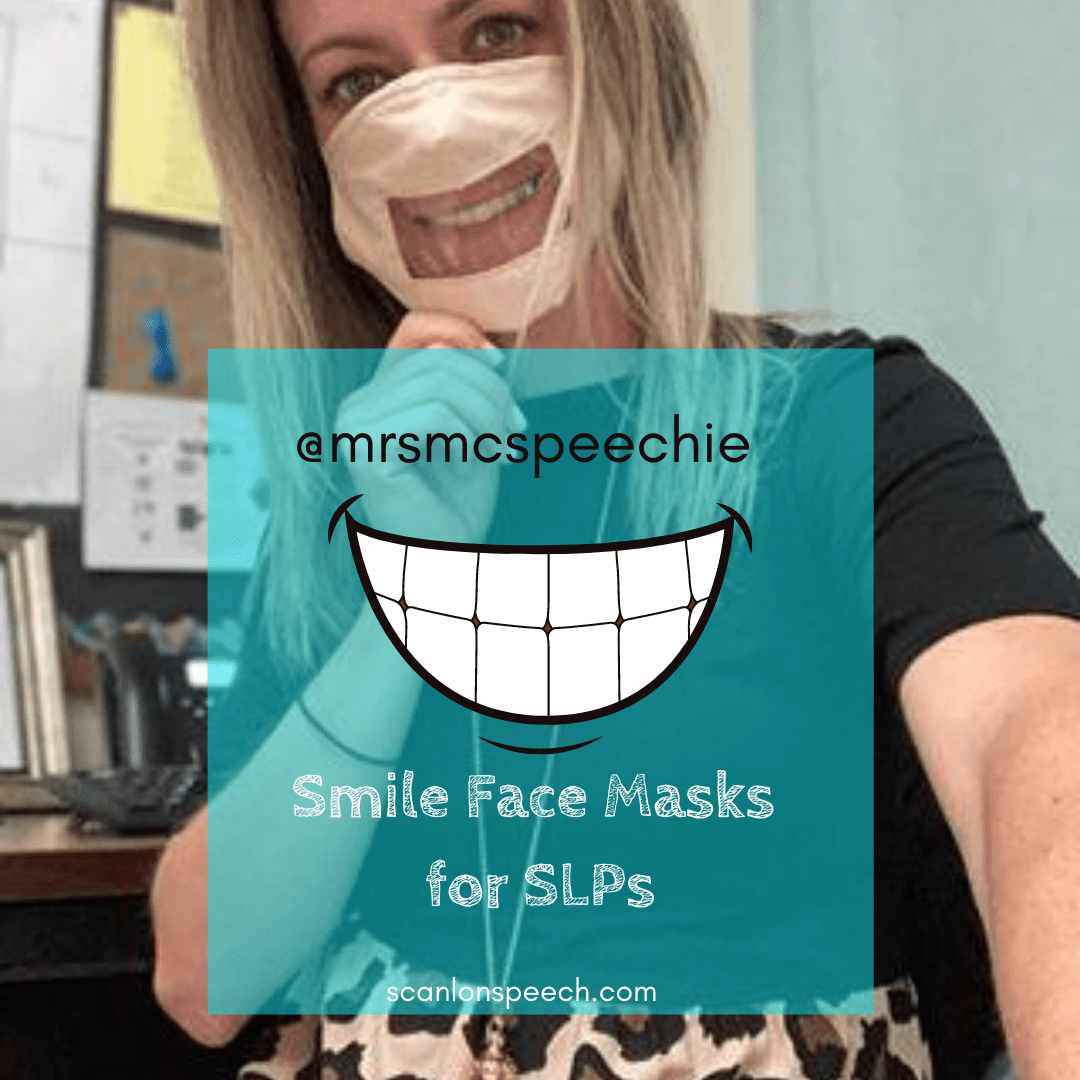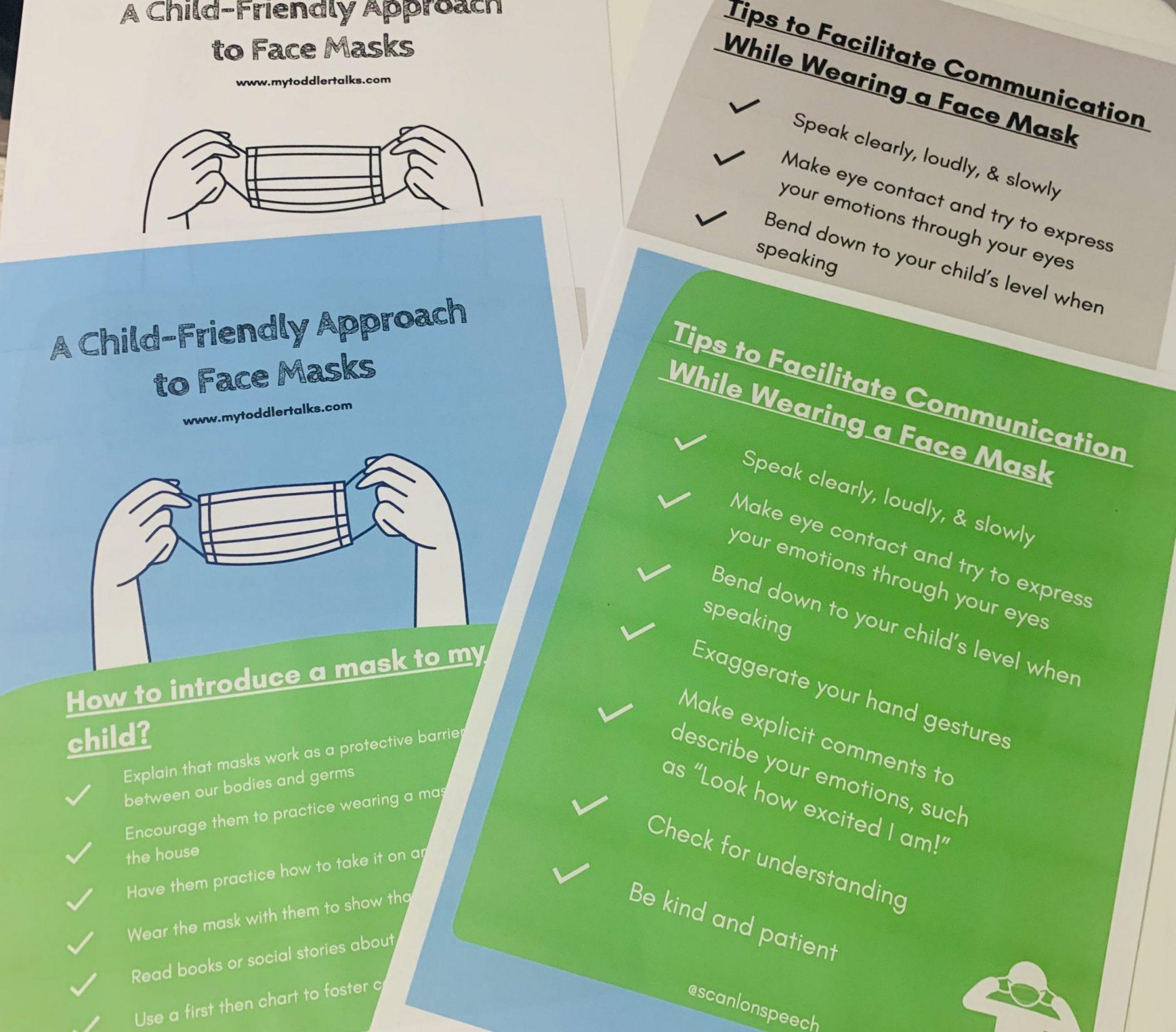Sign Up For Our E-Blast To Receive Information on our Books, Speech Therapy materials and our latest freebies!
A Child-Friendly Approach to Face Masks
As businesses, schools, and other public places begin to reopen, many parents are preparing how to keep their children healthy and safe as they are reintroduced to these areas. Most public places require the use of facial face masks so it’s important to introduce your child to face masks and teach them how to properly wear one while out.

The CDC (Centers for Disease Control and Prevention) has outlined the regulations for wearing face masks as follows:
- CDC recommends that people wear face masks in public settings and when around people who don’t live in your household, especially when other social distancing measures are difficult to maintain.
- Face masks may help prevent people who have COVID-19 from spreading the virus to others.
- Face masks are most likely to reduce the spread of COVID-19 when they are widely used by people in public settings.
- Face masks should NOT be worn by children under the age of 2 or anyone who has trouble breathing, is unconscious, incapacitated, or otherwise unable to remove the mask without assistance. (source: CDC Website)
Masks have become a vital part of public health, making it extremely important to teach little ones how to use them. Children over the age of two should be wearing a mask in settings where social distancing (6 feet away) cannot be followed, in areas where they can be in contact with surfaces that the virus could have been transmitted, and if they are experiencing symptoms of Coronavirus (Hackensack Meridian Health).
How do I introduce a mask to my child?
For some children, masks can be scary as they cover a majority of their face and the face of others. Facial expressions are often concealed, making it difficult to tell if a person is smiling and happy versus tight lipped and serious. Depending on the activity or the child’s exertion level, masks may even make breathing more difficult. (Kids Health). However, wearing a mask is a requirement in many schools and daycares as they slow the spread of coronavirus. My 3 year-old son wears a mask daily at his nursery school, and he does not complain about wearing it nor has he questioned it.

Here are a few simple tips to help your child wear a mask:
- Teach them that just like eating healthy, washing your hands, and keeping active, wearing a face mask keeps you healthy and happy! Explain that masks work as a protective barrier between our bodies and germs.
- Encourage them to practice wearing a mask around the house, practicing how to take it on and off – WITH CLEAN HANDS – and getting used to the feel of it.
- Wear the mask with them to show that it’s not scary! It might take them a little time to warm up to wearing a face mask, but once they understand the importance of it and get used to seeing you and other adults in them, they will be better prepared (Meraki Lane).
- Read a book about wearing masks (e.g. A Little Spot Wears a Mask by Diane Alber). Or, read a social story about wearing masks. Social stories were developed by Carol Gray, a former teacher and consultant to children, adolescents, and adults with autism. On her website, Gray defines social stories as: “…a social learning tool that supports the safe and meaningful exchange of information between parents, professionals, and people with autism of all ages. Autism Little Learners created this cute and FREE downloadable social story introducing the idea of wearing masks at schools. Reading such stories are intended to reduce the anxiety surrounding warning masks and set appropriate expectations.
- Use a First, Then Chart to visually explain to your child what needs to happen first before doing an activity. Fellow SLP, Jenna Rayburn Kirk, created this free downloadable First, Then Chart for children.

As an SLP and a mother of two young children, I have realized the impact that face masks have on communication. It is true that face-to-face interaction greatly promotes language development. This is because communication entails looking at a person, hearing the person, speaking to the person, observing their facial expressions, sometimes imitating their facial expressions or repeating their words, listening to questions, and responding to them. However, as mentioned above, facial expressions are more difficult to read while wearing a mask, as one cannot see the mouth. Additionally, for those who have difficulty projecting their voice (e.g. a person with Parkinson’s) their speech will be harder to hear. Surprisingly, an article I read, “The science of how you sound when you talk through a face mask”, summarized research from a study performed in 2013 and found that face masks of different varieties “…had surprisingly small effects on speech clarity.” Hmmm. I’m assuming the sampled population only included hearing adults with clear articulation skills? Additional more recent research contradicts the findings from 2013. Experimental research performed at the University of Illinois at Urbana-Champaign, revealed that the type of mask (e.g. medical, cloth, and transparent) DOES impact speech acoustics. They arrived at the following conclusions :
“…face masks attenuate high-frequency sounds in front of the talker, with the strongest attenuation above 4kHz. Ubiquitous polypropylene surgical masks offer the best acoustic performance among all masks tests. If those masks are not available, loosely woven 100% cotton masks perform well acoustically. Tightly woven cotton and cotton/spandex blends should be avoided if speech transmission is a concern.”
– Ryan M. Corey, Uriah Jones, and Andrew C. Singer
However, these researchers also admitted that their research “…did not consider the efficacy of masks at blocking respiratory droplets; it is possible that loosely woven fabrics that perform well acoustically are less effective against the virus and vice versa.” Thus, it is necessary to consider to variables. Using an amplification device or a lapel microphone coupled with a mask may be the best option for those who need to communicate in a group setting throughout the day (aka teachers).
The American Speech-Language-Hearing Association (ASHA) also states that face masks may muffle voices and make it increasingly difficult for individuals who have aphasia or voice problems. Individuals who stutter may even find wearing a mask cumbersome. James Hayden, an adult male who stutters, wrote an insightful account for The Stuttering Foundation on how the pandemic has affected his stuttering. In his opinion, wearing a mask has challenged his ability to effectively communicate, especially at work. He explains:
“Work is a whole other story. I find that my voice is muffled which causes me to speak louder or repeat myself a few times before my coworkers hear me. Whenever I have to speak louder, I tend to stutter more. Whenever I have to repeat myself, I’m inevitably fluent the first time, but stutter a lot when I repeat what I said. I also can’t see my audience’s reaction, nor can they see mine. My non-verbal cues to let them know that my stutter is ok and nothing is wrong with me are severely limited because of my mask.”
– James Hayden
So, what can we do to ensure others understand what we say? Or, what can we do to better convey our intentions and feelings while a majority of our face is covered?

Here are some tips to facilitate effective communication during the pandemic:
- Speak clearly, slowly, and properly project your voice
- Minimize background noise – if possible
- Make eye contact and try to express your expressions through your eyes
- Bend down to your child’s level when you talk to them
- Exaggerate your hand gestures
- Make explicit comments to describe your emotions to your child, such as “I am so happy right now! I have a huge smile on my face!”
- Check for understanding by asking if they understood you
- Be kind and patient – it may be difficult for the other person to hear, speak, or communicate
Speech language pathologists and some professionals are also choosing to wear a transparent face mask (aka a smile mask) that has a clear window panel to show the mouth. This is a fellow SLP and friend, Kian McBurnie (aka MrsMcspeechie) showing how her transparent mask:

Despite all these contraptions, you can still see her smiling, pleasant face!
Sometimes these smile masks fog up but the advantage is that the child sees your mouth or at least an element/portion of your mouth. Kian uses Dawn dish detergent to help decrease the fogging – it can last for up to an hour or hour and a half before you have to reapply the Dawn.
This whole pandemic is about adaptation and flexibility. We have been forced to adopt a new lifestyle to protect our health, making it important to encourage our children to protect their health as well as respect the health of others by wearing a mask.
To download these tips and handouts, please click here or the picture below. Wishing you a healthy and wonderful start to the school year!

Homeschooling During a Pandemic – Week 3
The Zen of Practicing Gratitude
Back to blog